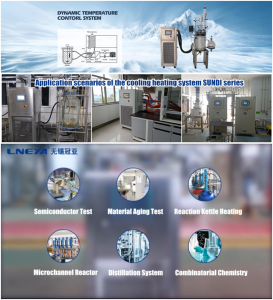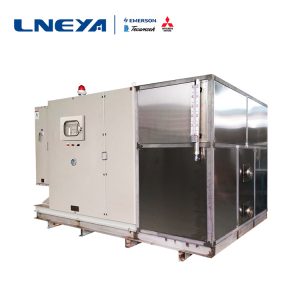隔離リアクター用温度制御機器の使用説明書
The reaction kettle is a commonly used reactor in pharmaceutical and chemical production. The temperature control equipment of the isolated reaction kettle is realized by controlling two doors, namely the heating water valve and the cooling water valve. make it even temperature. The temperature of the isolation reaction kettle is controlled in the heating stage, the heating water valve is opened, and the coil pipe in the kettle is connected with heating water, so that the temperature rises, and the rate of temperature rise is controlled by controlling the valve opening. After heating to the predetermined reaction temperature The heating was stopped, and cooling water was passed through the jacket during the reaction to remove the excess heat generated by the reaction, and the temperature was controlled to keep constant.

The choice of heat transfer medium for temperature control of isolation reactor is determined according to the process temperature requirements of each factory product. Common heat transfer mediums include superheated steam and heat transfer oil. Temperature measurement is usually composed of thermal resistance or thermocouple and its transmitter. The temperature of the heat-conducting medium flowing into the reactor is required to be kept constant. By adjusting the flow rate of the heat-conducting medium flowing into the jacket of the reactor, the temperature of the materials in the reactor can be controlled to meet the process requirements.
After the temperature control equipment of the isolation reactor is finished feeding, the reactor is heated with hot water. The raw material is fully mixed with the catalyst and absorbs the heat provided by the hot water. When the temperature reaches a certain value, the exothermic reaction begins. In this stage, it is necessary to raise the temperature or pressure in the kettle to the state where the reaction starts in a relatively short period of time, and it is necessary to keep the temperature rising continuously.
The temperature control of the isolated reactor is accompanied by a strong exothermic effect, and there is a positive feedback self-excited relationship between the exothermic rate of the reaction and the reaction temperature. This stage is the difficult point of control, which directly affects the quality of the product.
LNEYA’s isolated reaction kettle temperature control equipment – cooling and heating thermostat, compared with dynamic temperature control technology to control the temperature of the heat transfer medium, it also controls the temperature of the material within the specified range, which improves the work efficiency. The pipeline circulation system improves the power density ratio, reduces the usage of heat transfer medium, and saves energy.
関連推奨品
-
エチレングリコールチラーの主な目的は、反応器の加熱・冷却ユニットである。
1186グリコールチラーは、高純度金属、希少物質の精製、実験室環境でのシミュレーション、マグネトロンスパッタリング、真空コーティングなどの産業に適しています。大型クライオジェニックポンプユニットにより、労働環境の冷却が可能です。
詳細を見る -
産業用チラーを使用する企業のための省エネのヒント
1001省エネルギーが叫ばれる昨今、電力消費は常に人々の関心事である。工業設備が電力を消費することは誰もが知っている。多くの化学材料製造企業にとって、電力消費は大きなプレッシャーとなっている。
詳細を見る -
小型水冷チラーの冷媒充填方法について
1145私たちの生活の中で、冷凍は誰もがよく知っていると思います。中央空調や工業生産プロセスの冷却業界では、小型の水冷式チラーが一般的です。このユニットは、コンプレッサーで構成されています。
詳細を見る -
Vocs 凝縮分離装置膨張弁メンテナンス説明書
924一旦、凝縮分離装置の膨張弁が故障すると、その解決策が間に合わなければ、凝縮分離装置全体が使用できなくなる可能性がある。そのため、凝縮分離装置の膨張弁の故障は、凝縮分離装置全体が使用できなくなる可能性がある。
詳細を見る
 LNEYA工業用冷凍機 メーカー サプライヤー
LNEYA工業用冷凍機 メーカー サプライヤー













